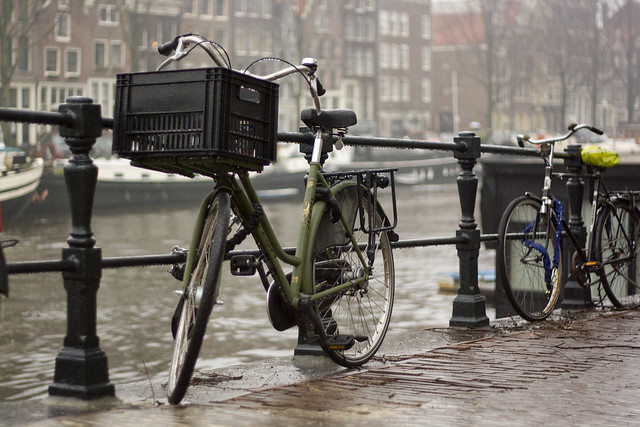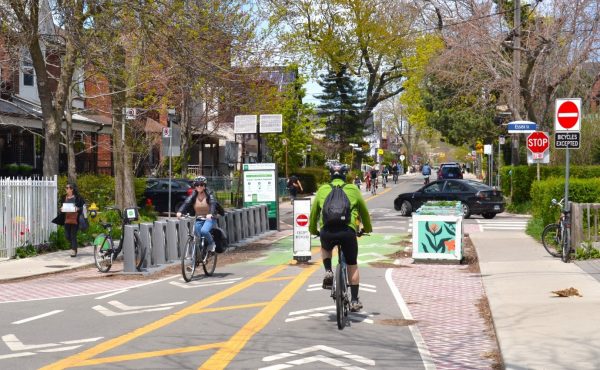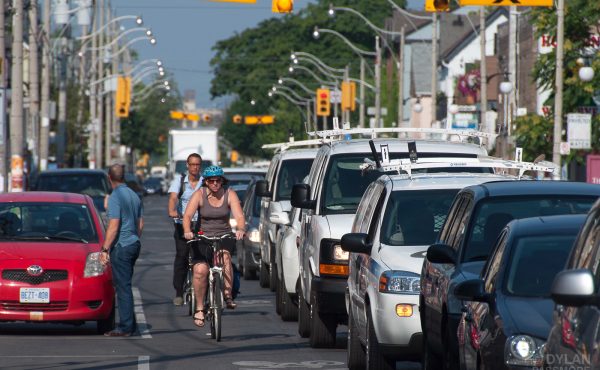
This regular online series will feature interviews with fascinating and influential urban thinkers, with a focus on discussing how Toronto can become a more engaged, accessible, and sustainable city.
Eric Kamphof is general manager of Curbside Cycle and Fourth Floor Distribution. For 20 years, Eric and his partners have been busy promoting “barrier-free cycling” both in Toronto and in other North American cities. Spacing sat down with Eric to discuss his views on the evolution of Toronto’s cycling culture and to find out exactly what he and his partners mean by “barrier-free.”
Spacing: Eric, what is “barrier-free” cycling?
Kamphof: It’s cycling that is inclusive and appeals to a broad range of people. What I hated about cycling when I first got involved in the industry was the overwhelming and exclusive “dude” culture. For too long, cycling was male-dominated and oriented around performance or adrenaline cycling. Beginning with the bike itself, we try to make cycling appeal ordinary people and to all genders. The bikes we sell have chain cases, they’re in an upright riding position, they’re low maintenance, and thus could be stored outside in a northeast winter. It’s funny because these bikes are often heralded as a revolutionary object but they’re the kind that was once dominant throughout the world. We want to remind people that this is what a bicycle looked like before the before the ascendancy of suburbs and the performance bike.
Spacing: How did the popularity of the upright bike decline?
Kamphof: You can create a direct link between the decline of the bicycle and mid-20th century suburban expansion. At the turn of 20th century, North American cities supported a dense urban culture where 90% of activities took place within 10km of your home. In that situation, the bicycle was an ideal mode of transportation and upright bikes, or “city-bikes,” were everywhere. But as suburbs evolved and people began to live further from their daily destinations, the bicycle fell into relative disuse. Cycling also didn’t really work in suburbs because cul-de-sacs don’t encourage terribly serious biking. Your main supplier in that situation is a store like Canadian Tire where you could buy relatively inexpensive, lesser quality bikes. Out in the countryside, cycling evolved into an adrenaline sport, i.e. performance road racing, mountain biking and BMX and whole new bicycle varieties were invented while cycling’s urban antecedents was slowly stripped away.
Spacing: What is a “Dutch Bike”?
Kamphof: The Dutch bike is essentially a city-bike that is extremely durable. I’m of Dutch ancestry and I can tell you that the Dutch, being both incredibly practical and frugal, always bought things right the first time and expected things to last. Holland has no space for garbage dumps, so a disposable culture cannot exist there. What evolved from that was a bicycle that you can’t cut corners with and fits the daily needs of cyclists. Such needs are; getting to work in your standard clothes, not sweating excessively, and storing your bike outside regardless of weather conditions. Dutch bikes are also neither fast nor slow but just efficient. The Dutch are really like the Galapagos Islands of the city-bike world in that they created their own evolutionary species. But it’s not entirely fair to call these bikes “Dutch” because the British invented them. Although Britain, like North America, bought into automobile car culture whereas a cycling culture persisted in Holland.
Spacing: The durable, upright bike you keep describing sounds a lot like Bixi. Is that an adequate comparison?
Kamphof: Absolutely. The very first bike-share program of any repute and success was Paris’ and it was a Dutch company that supplied those bikes. In many ways Bixi is the evolution of the Velib bike. Bixi’s designer was pretty smart. I really respect that bike.
Spacing: I’ve heard you say that out of the five largest North American cities, Toronto has the best cycling culture. How so?
Kamphof: I judge a bike culture not by infrastructure but by a human being and a bicycle. In terms of sheer volume, Toronto is doing very well. We’ve smartly followed the example of cities like Paris and Copenhagen. As recently as 15 years ago, Paris was not a cycling city but they had real wisdom to create a bicycle that facilitated the development of a bicycle culture — Velib. Now Paris has a large volume of riders and the government responded by building bike lanes. It’s a real bottom-up approach. New York City, by contrast, is using a top-down “if you build it, they will come” strategy by building the infrastructure first. But even in Field of Dreams, if you didn’t have a baseball glove you weren’t going to play. NYC’s bike lanes are underutilized likely suggesting that they require a more marketable bike. Regardless, the situation in New York is still great because of the way the city government encourages cycling.
Spacing: Since you mentioned bike lanes, what’s your opinion on them?
Kamphof: Our goal as an activist bike store is simply to encourage people to ride bikes and create as many types of cyclists as possible. We’re hoping that we would be partly responsible with flooding the city with so many bikes that drivers themselves would be be asking City Hall to install bike lanes as cyclists were slowing them down. But now the rhetoric has shifted to lets tear up streetcar tracks and bike lanes and that really shocked me. The debate is so bifurcated. We rent out bikes to tourists and the first thing they say to us when they get back is “I can’t believe how many cyclists there are in this city.” There should be an allowance for the fact that cyclists are a downtown reality but it feels like that fact is being ignored quite deliberately. Our administration is choosing to forget that people on bikes are citizens who need to be protected. Not one citizen should get priority over another, therefore bike lanes.
Photo by Daniel Davies





3 comments
Great article. Oh, they have a garbage dump or two back in the old country, but something like a bike never really dies there – it just gets endlessly fixed up.
Good insight into the top-down, infrastructure approach of New York and the grass-roots, everyone-rides-even-without-infrastructure approach of Toronto. If one could ever marry the two it would be sweet indeed.
I am a great admirer or Eric Kamphof and Curbside Cycle. Eric sold me the bicycle that takes me to work and everywhere I go in Toronto. His mechanic Ellie is an incredibly smart guy who does such a good job with the planned maintenance that I have never, ever had a breakdown on Toronto’s streets. Not even a flat tire.
Of course, having no flats is largely due to the factory-standard Schwalbe puncture-resistant tires that came with my bike, a Pashley Sovereign Roadster. And the bike itself is incredibly durable. After the years of use that I’ve already put on it, I believe that the bike will outlive me. I’m leaving it to my oldest son in my will.